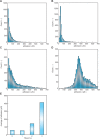Selection of DNA aptamers using atomic force microscopy
- PMID: 19955232
- PMCID: PMC2831320
- DOI: 10.1093/nar/gkp1101
Selection of DNA aptamers using atomic force microscopy
Abstract
Atomic force microscopy (AFM) can detect the adhesion or affinity force between a sample surface and cantilever, dynamically. This feature is useful as a method for the selection of aptamers that bind to their targets with very high affinity. Therefore, we propose the Systematic Evolution of Ligands by an EXponential enrichment (SELEX) method using AFM to obtain aptamers that have a strong affinity for target molecules. In this study, thrombin was chosen as the target molecule, and an 'AFM-SELEX' cycle was performed. As a result, selected cycles were completed with only three rounds, and many of the obtained aptamers had a higher affinity to thrombin than the conventional thrombin aptamer. Moreover, one type of obtained aptamer had a high affinity to thrombin as well as the anti-thrombin antibody. AFM-SELEX is, therefore, considered to be an available method for the selection of DNA aptamers that have a high affinity for their target molecules.
Figures





Similar articles
-
Tracking the emergence of high affinity aptamers for rhVEGF165 during capillary electrophoresis-systematic evolution of ligands by exponential enrichment using high throughput sequencing.Anal Chem. 2013 Nov 19;85(22):10761-70. doi: 10.1021/ac401875h. Epub 2013 Nov 1. Anal Chem. 2013. PMID: 24125636 Free PMC article.
-
Development of a novel aptamer-based sensing system using atomic force microscopy.J Biosci Bioeng. 2011 Nov;112(5):511-4. doi: 10.1016/j.jbiosc.2011.07.008. Epub 2011 Aug 6. J Biosci Bioeng. 2011. PMID: 21821470
-
The Effects of SELEX Conditions on the Resultant Aptamer Pools in the Selection of Aptamers Binding to Bacterial Cells.J Mol Evol. 2015 Dec;81(5-6):194-209. doi: 10.1007/s00239-015-9711-y. Epub 2015 Nov 4. J Mol Evol. 2015. PMID: 26538121
-
SELEX Modifications and Bioanalytical Techniques for Aptamer-Target Binding Characterization.Crit Rev Anal Chem. 2016 Nov;46(6):521-37. doi: 10.1080/10408347.2016.1157014. Epub 2016 Mar 15. Crit Rev Anal Chem. 2016. PMID: 26980177 Review.
-
Development of Cell-Specific Aptamers: Recent Advances and Insight into the Selection Procedures.Molecules. 2017 Nov 27;22(12):2070. doi: 10.3390/molecules22122070. Molecules. 2017. PMID: 29186905 Free PMC article. Review.
Cited by
-
Strategies for the discovery of therapeutic aptamers.Expert Opin Drug Discov. 2011 Jan;6(1):75-87. doi: 10.1517/17460441.2011.537321. Expert Opin Drug Discov. 2011. PMID: 21359096 Free PMC article.
-
Aptamers as targeted therapeutics: current potential and challenges.Nat Rev Drug Discov. 2017 Mar;16(3):181-202. doi: 10.1038/nrd.2016.199. Epub 2016 Nov 3. Nat Rev Drug Discov. 2017. PMID: 27807347 Free PMC article. Review.
-
Characterization of enhanced monovalent and bivalent thrombin DNA aptamer binding using single molecule force spectroscopy.Biophys J. 2011 Oct 5;101(7):1781-7. doi: 10.1016/j.bpj.2011.07.054. Biophys J. 2011. PMID: 21961605 Free PMC article.
-
Aptamers and Their Significant Role in Cancer Therapy and Diagnosis.Biomedicines. 2015 Sep 1;3(3):248-269. doi: 10.3390/biomedicines3030248. Biomedicines. 2015. PMID: 28536411 Free PMC article. Review.
-
A Genosensor Based on the Modification of a Microcantilever: A Review.Micromachines (Basel). 2023 Feb 10;14(2):427. doi: 10.3390/mi14020427. Micromachines (Basel). 2023. PMID: 36838127 Free PMC article. Review.
References
-
- Bass L, Cech R. Specific interaction between the self-splicing RNA of Tetrahymena and its guanosine substrate: implications for biological catalysis by RNA. Nature. 1984;308:820–826. - PubMed
-
- Gold L, Polisky B, Uhlenbeck O, Yarus M. Diversity of oligonucleotide functions. Annu. Rev. Biochem. 1995;64:763–797. - PubMed
-
- Osborne S, Ellington A. Nucleic acid selection and the challenge of combinatorial chemistry. Chem. Rev. 1997;97:349–370. - PubMed
-
- Wilson DS, Szostak Z. In vitro selection of functional nucleic acids. Annu. Rev. Biochem. 1999;68:647–661. - PubMed
-
- Misono TS, Kumar KR. Selection of RNA aptamers against human influenza virus hemagglutinin using surface plasmon resonance. Anal. Biochem. 2005;342:312–317. - PubMed
MeSH terms
Substances
LinkOut - more resources
Full Text Sources
Other Literature Sources
Research Materials
Miscellaneous

